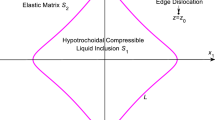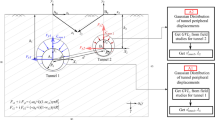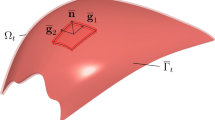Abstract
In this paper, the stress intensity factors of interacting kinked cracks in a solid and the overall strains of the solid under uniaxial tension are determined numerically. The kinked cracks are in general asymmetric, unequal, and arbitrarily oriented and located in the solid. Each kinked crack, assumed to be traction free, consists of a main crack and kinks. The analysis makes use of the dislocation modeling of kinks, and the superposition of problems of straight cracks subjected to dislocation and traction loadings. The model is used to investigate the dependence of the stress intensity factors and the overall strains on crack geometry (straight, Z-shaped and U-shaped cracks) and crack configuration (collinear and stacked cracks, periodic and random crack arrays).
Similar content being viewed by others
References
Andersson, A. (1969). Stress intensity factors at the tips of a star-shaped contour in an infinite tensile sheet. Journal of the Mechanics and Physics of Solids 17, 405-417.
Bilby, B.A. and Cardew, G.E. (1975). The crack with a kinked tip. International Journal of Fracture 11, 708-711.
Cotterell, B. and Rice, J.R. (1980). Slightly curved or kinked cracks. International Journal of Fracture 16, 155-169.
Erdogan, F. (1962). On the stress distribution in plates with collinear straight cuts under arbitrary loads. Proceedings of the Fourth U.S. National Congress of Applied Mechanics 1, 547-554.
Gerasoulis, A. (1982). The use of quadratic polynomials for the solution of singular integral equations of Cauchy type. Computers and Mathematics with Applications 8, 15-22.
Hashin, Z. (1988). The differential scheme and its application to cracked materials. Journal of the Mechanics and Physics of Solids 36, 719-734.
He, M.Y. and Hutchinson, J.W. (1989). Kinking of a crack out of an interface. Journal of Applied Mechanics 56, 270-278.
Horii, H. and Nemat-Nasser, S. (1986). Brittle failure in compression: splitting, faulting and brittle-ductile transition. Philosophical Transactions of the Royal Society of London A319, 337-374.
Kitagawa, H., Yuuki, R. and Ohira, T. (1975). Crack-morphological aspects in fracture mechanics. Engineering Fracture Mechanics 7, 515-529.
Laws, N. and Brockenbrough, J.R. (1987). The effect of microcrack systems on the loss of stiffness of brittle solids. International Journal of Solids and Structures 23, 1247-1268.
Lo, K.K. (1978). Analysis of branched cracks. Journal of Applied Mechanics 45, 797-802.
Mauge, C. and Kachanov, M. (1992). Interacting arbitrarily oriented cracks in anisotropic matrix: Stress intensity factors and effective moduli. International Journal of Fracture 58, R69–R74.
Muskhelishvili, N.I. (1977). Some Basic Problems of the Mathematical Theory of Elasticity. Noordhoff, Leyden, 732p.
Nemat-Nasser, S. and Obata, M. (1988). A microcrack model of dilatancy in brittle materials. Journal of Applied Mechanics 55, 24-35.
Niu, J. and Wu, M.S. (1997). Strong interactions of morphologically complex cracks. Engineering Fracture Mechanics 57, 665-687.
Tada, H., Paris, P.C. and Irwin, G.R. (1973). The Stress Analysis of Cracks Handbook, Del Research Corporation, Hellertown, Pennsylvania.
Theocaris, P.S. (1977). Asymmetric branching of cracks. Journal of Applied Mechanics 44, 611-618.
Vitek, V. (1977). Plane strain stress-intensity factors for branched cracks. International Journal of Fracture 13, 481-501.
Wu, M.S. (1993). Effective moduli of finite anisotropic media with cracks. Mechanics of Materials 12, 139-158.
Wu, M.S. (1994). Material anisotropy effects on stress intensity factors and the effective elastic compliance. Engineering Fracture Mechanics 48, 177-198.
Author information
Authors and Affiliations
Rights and permissions
About this article
Cite this article
Niu, J., Wu, M.S. Analysis of Asymmetric Kinked Cracks of Arbitrary Size, Location and Orientation – Part II. Remote Tension. International Journal of Fracture 89, 59–84 (1998). https://doi.org/10.1023/A:1007476710235
Issue Date:
DOI: https://doi.org/10.1023/A:1007476710235




